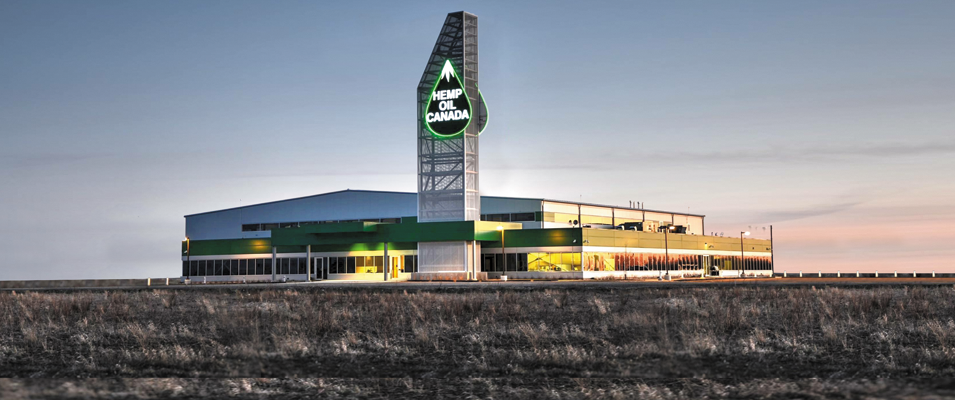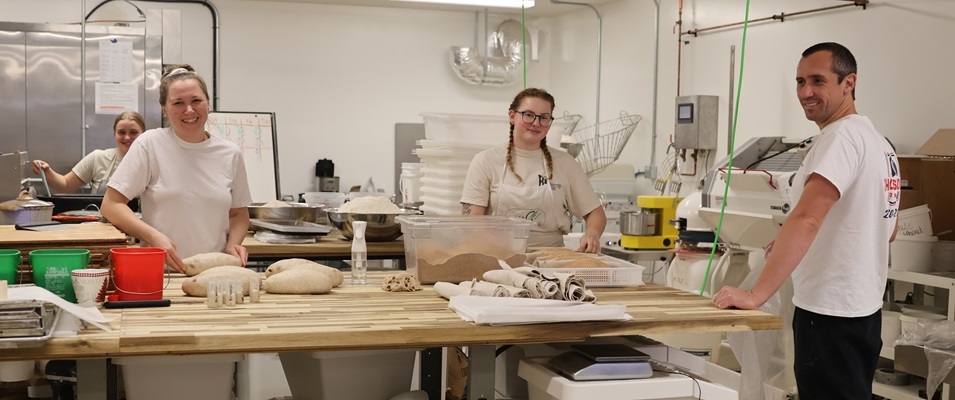
Few entrepreneurial success stories boast as big a wow factor as Manitoba’s Hemp Oil Canada (HOC). From its inception less than 20 years ago to today, HOC’s current position on the global market stands as testament to the fortitude and creativity of one man: Shaun Crew.
Though its beginnings were meagre, the company now stands proudly in Ste. Agathe’s Riel Industrial Park, a towering beacon to travellers along Highway 75. Crew has since sold the multimillion-dollar venture, but as its early founder he has a rich story to tell.
“I founded Hemp Oil Canada in February 1998, just one month before Health Canada legalized the cultivation of industrial hemp after 60 years of prohibition,” says Crew. “I had heard that industrial hemp was going to be relegalized in Canada. I knew the big grain companies wouldn’t touch such a controversial crop, yet at the same time I saw a great opportunity to develop healthy food products and ingredients from the nutritious hemp seed.”
To suggest that the risk of the investment was high would be an understatement. For six decades, the production and use of this versatile plant was under an international ban due to its association with marijuana. Both are varieties of the same species: cannabis.
Though the plants are indeed similar, hemp refers to strains of cannabis that have been bred specifically for their fibre, which has a multitude of useful aspects, and seeds and flowers which are proven to have valuable health benefits beyond many other natural herbs. Through the breeding process, the psychoactive components known to produce a high have been reduced to very low levels without compromising the benefits of the plant.
The History of Hemp
Hemp enjoyed a rich history before its prohibition in 1937. According to the Canadian Hemp Trade Alliance’s website, “Hemp has been cultivated on planet earth for over 10,000 years. It has been an important source of food and fibre with references dating back to ancient China and Mesopotamia. Applications of hemp plants evolved from simple rope and coarse woven fabric to paper and sail cloth. Hemp seed and flower tops were known to provide medical comfort from a variety of ailments during the period of 2700 BC through to Roman times.”1
Hemp continued in its notoriety over the centuries. It was a vital crop for North America from the seventeenth to early twentieth century and was utilized by manufacturers for various applications such as oil, clothing, and rope. Hemp fibre was and still is known to be one of the strongest and most durable of all natural fibres.
Belief in the product was so strong that the 1938 edition of Popular Mechanics wrote an article describing hemp as the “new billion-dollar crop.” Early car manufacturer Henry Ford was equally optimistic about the plant’s potential when, in 1930, he produced a Model T prototype manufactured with hemp fibre and fuelled completely by hemp oil. The body of the vehicle was said to be “invincible.”2
Biofuel made from hemp is considered much safer and less toxic to the environment than traditional fossil fuels. As a crop, it grows fast and leaves the ground in a better state after it’s harvested. As a fibre option, one acre of hemp will produce as much fibre as two to three acres of cotton, as much paper as two to four acres of trees, and has been seen as a viable alternative to oil in the making of plastic.
But the billion-dollar hemp market was not to be. In 1937, American president Franklin D. Roosevelt passed The Marijuana Tax Act, making it illegal to produce cannabis in any form, resolving that the plant was a narcotic which needed to be aggressively controlled. The moratorium began in spite of opposition from the American Medical Association.
In 1961, the United Nations drafted the Single Convention on Narcotic Drugs, creating a universal standard for drug control which included cannabis in all its forms. From that time until today, industrial hemp has been considered a controlled substance along with heroin, cocaine, and a host of barbiturates, regardless of its psychoactive levels.
Finally, the Canadian government created new legislation in 1998 which would allow for the planting and processing of industrial hemp. Even so, it remains under Health Canada’s close scrutiny. But for the first time in 60 years, farmers were able to grow it for food and fibre and manufacturers were able to process, export, and ship hemp products over Canada’s borders. The U.S. did not follow suit, and as of today the moratorium on producing industrial hemp for commercial purposes continues.
Initially, this “new” Canadian crop faced many hurdles due to the effectiveness of the American and U.N. campaigns against it. In its early stages, supply exceeded demand and many forward-thinking farmers and entrepreneurs didn’t survive in the market. They needed to re-educate consumers in order to build demand, and at the turn of the twenty-first century consumers began to once again recognize hemp for its superior nutritional value. The market for hemp fibre is also growing.
Today, processed Canadian hemp products are being shipped to more than 30 different countries worldwide. And although hemp products are illegal to produce south of the border for commercial purposes, the U.S. remains our largest single food market for industrial hemp products.
Hemp Oil Canada’s Emergence
While Crew was likely considered crazy by many for his early investment in a product not yet legislated by the government, or recognized by the world, there is no question that he was a visionary.
“My philosophy was to walk before we run and intentionally grow the business as the market developed,” says Crew. “We had to develop new products from non-existent processes and sell them into markets that didn’t exist in early 1998. Developing the market from nothing has taken a lot of education, one customer at a time.”
HOC began as a small venture, renting space in a warehouse in St. Norbert. The company’s first oil press was acquired through a trade of company shares. Eight years later, the market was seeing some growth and the company relocated to Ste. Agathe, Crew’s hometown. He purchased the former Case IH building on Main Street and effectively tripled the size of his production space.
During this time, the company experienced double-digit growth, quickly adding pressure to his space and production capacity. Two separate expansions and the addition of more employees alleviated the demand for a period of time.
“Hemp Oil Canada has experienced growth of 20 to 25 percent every year since its inception,” Crew says.
After 2010, the business doubled in size every couple of years.
“We were ideally positioned to capitalize on the consumer demand for healthier, more nutritious food ingredients,” adds Crew. “Driven by this consumer demand, food manufacturers were actively seeking new food ingredients to bolster the nutritious content of their product offering. Hemp foods provided a powerhouse of nutrition with a highly digestible, plant-based protein, Omega 3 and 6 fatty acids, and a very interesting array of vitamins and minerals. And most importantly, hemp foods taste great, making these ingredients easy to incorporate into one’s diet.”
Unfortunately, HOC’s production area experienced a catastrophic fire in 2013. Crew recognized this as an opportunity, not an inhibitor, and the design of a new, state-of-the-art facility began. Construction commenced in the fall of 2015 in the community’s industrial park and production once again followed with 40 employees on the payroll.
“As a volunteer on the local Community Development Corporation, I am the chairman of the Riel Industrial Park,” says Crew. “I always knew that one day the company would relocate to the industrial park as the business grew.”
Today, HOC is the world’s largest producer and processor of bulk hemp food products and ingredients. These products include bulk seed oil, oil gel caps, hulled hemp seeds, toasted hemp seeds, flour, protein powder, and high-fibre powder. All of the products are produced under the high standards set by the Global Foods Safety Initiative.
“Hemp Oil Canada’s primary customer is value-added food manufacturers looking for healthier, nutrition-packed food ingredients,” adds Crew. “However, we also supply the beauty and bodycare industry, as well as the companion pet food industry.”
Crew has been the recipient of a number of business achievement awards over the years, but none was more meaningful than his most recent, Hemp Industries Association’s Lifetime Achievement award for his nearly 20 years of hard work in an industry once considered volatile and uncharted.
Crew sold the business in late 2015 to a merger of the two largest hemp food companies in the world: Fresh Hemp Foods and Compass Diversified Holdings (CDH). CDH is an American private equity firm trading on the New York stock exchange. He remained on in a transitional management role for the next 18 months, after which he effectively retired in May 2017. He is still the second largest shareholder in the business.
“Although I retired from Hemp Oil Canada, I can’t honestly say that I am fully retired,” says Crew. “I continue to volunteer on a number of other boards. I will [also] continue to operate, manage, and develop the industrial park in Ste. Agathe, in addition to looking after a number of other properties that I own.”


















